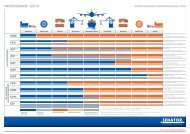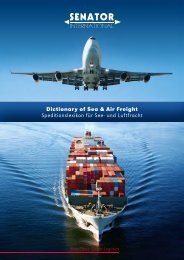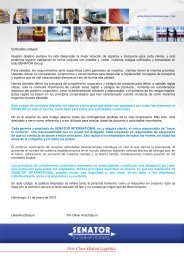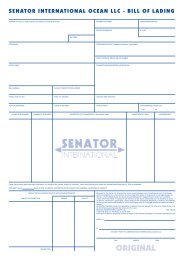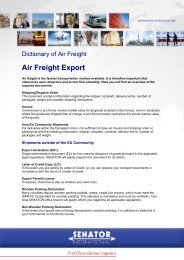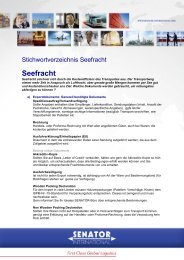Download here the sea freight directory - Senator International
Download here the sea freight directory - Senator International
Download here the sea freight directory - Senator International
Create successful ePaper yourself
Turn your PDF publications into a flip-book with our unique Google optimized e-Paper software.
Dictionary of Sea FreightSea FreightSea <strong>freight</strong> is a cost-efficient form of transportation. Even though this method oftransportation is slower than air <strong>freight</strong>, large quantities of goods shipped via <strong>sea</strong> <strong>freight</strong>arrive at <strong>the</strong>ir destination in good condition and in a cost-effective manner. Which documentsare necessary to ensure a smooth clearance and dispatch of goods?a) Export DocumentsGenerally required documentsShipping order/Dispatch orderShould include information concerning <strong>the</strong> recipient, delivery conditions, shipment information(including content, number of packages, weight, measurements, information regarding <strong>the</strong>goods) and, if applicable, shipping deadlines and o<strong>the</strong>r important information concerningtransportation provisions, such as stackability of pallets, etc.InvoiceCommercial or Pro-forma invoice which states <strong>the</strong> value of all <strong>the</strong> invoiced goods includingthose shipped free of charge.Export Declaration/Single Administrative Document (EU)Document which sets forth <strong>the</strong> customs relevant information for a shipment leaving <strong>the</strong>customs area.Conditionally required documentsLetter of CreditIn <strong>the</strong> event that you are selling goods on <strong>the</strong> basis of a “Letter of Credit”, we would like toobtain a copy of <strong>the</strong> Letter of Credit as soon as possible, to ascertain that all <strong>the</strong> terms andconditions in <strong>the</strong> Letter of Credit can be fulfilled and that you can obtain <strong>the</strong> corresponding<strong>freight</strong> documentation from us immediately.Export permit/licenceThis is not required for every export and depends on <strong>the</strong> type of goods and <strong>the</strong> country ofdestination (if you have any questions, please contact us at any time).Wooden Packaging DeclarationMany countries require wooden packing (pallets, crates and boxes) to meet <strong>the</strong> ISPM-Nr.-15standard for wood packaging. This regulation is mandatory and must be verifiable.Your local SENATOR-office branch will gladly inform you regarding applicable regulations.Non-Wooden Packing DeclarationIn <strong>the</strong> event that your goods are not transported in wooden pallets or crates, it is sufficient todeclare in your commercial or Pro-forma invoice that <strong>the</strong> packaging contains no wood.
a) Import Document.B/L(Bill of Lading)Bill of Lading (Transportation document)Documents for customs clearanceCommercial invoice, packing list, certificate of origin. For goods originating from countries witha preferential qualification, a preferential origin certificate should be included as it may reduce<strong>the</strong> customs duty.Import of goods that require import authorizationThe import of certain goods (e.g. clothing) may be subject to partially strictly regulatedprovisions. In many cases an import authorization is required. The documents required toobtain such an import authorization are governed by <strong>the</strong> respective country of origin or trade.As a general rule, an application for an import authorization may be applied for prior to <strong>the</strong>arrival of <strong>the</strong> shipment, provided that all essential documents from your suppliers are availablein a timely manner.Konnossement-ArtenThe transportation document (Bill of Lading or B/L Bill of Lading) is used as:Confirmation that <strong>the</strong> shipment was assumed by <strong>the</strong> carrierConfirmation regarding <strong>the</strong> <strong>sea</strong> <strong>freight</strong> contractNegotiable instrument (transfer document)Bill of Lading terms and conditionsThe terms and conditions of <strong>the</strong> carrier issuing <strong>the</strong> Bill of Lading are listed on <strong>the</strong> front side of <strong>the</strong>document. The reverse side of <strong>the</strong> document contains information regarding <strong>the</strong> shipper, consignee, adescription of goods, etc., in o<strong>the</strong>r words, all <strong>the</strong> information concerning <strong>the</strong> shipment to betransported. Typically, banks will require a "shipped on board” Bill of Lading in <strong>the</strong> letter of credit.A Bill of Lading must contain <strong>the</strong> following informationName of <strong>the</strong> carrierName of <strong>the</strong> shipper (can also be <strong>the</strong> <strong>freight</strong> forwarder)Name of <strong>the</strong> vesselName of <strong>the</strong> recipient (or an Order)Loading portPort of destinationLading informationPrepaid or collectPlace and date of issueDelivery agentNumber of issued originalsOn-Board-Notations
Port-Port Bill of LadingFrom <strong>the</strong> port of loading to <strong>the</strong> port of dischargeMultimodal Combined Transport Bill of LadingFrom <strong>the</strong> named place of receipt to <strong>the</strong> named place of delivery.FIATA-B/LIs a Multimodal Combined Transport Bill of Lading that is generally issued by shipping agents.EndorserIs someone who endorses an endorsable document and thus assigns his rights under a commercialinstrument over to ano<strong>the</strong>r.EndorsementEndorsements of Bills of Lading, similar to those in o<strong>the</strong>r types of bill of exchange transactions, arerequired to transfer rights of a Bill of Lading to third parties and/or to assert a delivery claim against <strong>the</strong>carrier. The recipient must render an additional endorsement in order release <strong>the</strong> cargo from <strong>the</strong>carrier for delivery.Container - standardized steel box.Water navigation without containers has become unimaginable. The reason for this is standardization.The standardized containers can be used for many different means of transportation. The containercan also be used as a loading device.Variations of <strong>sea</strong> transportLCL (less than container load)In LCL-shipments (also known as a “less than container load”), <strong>the</strong> combined volume and/or weight ofall <strong>the</strong> individual deliveries is too low to fill up an entire container. As a result, in practice, multipleLCL-deliveries (which may be for different shippers with <strong>the</strong> same port of destination) will be combinedinto one container (=collective container) at <strong>the</strong> port of shipment.FCL(full container load)Exclusive containers will be loaded when:The volume and weight of <strong>the</strong> delivery is large enough to make transportation in an exclusivecontainer economical.The nature of <strong>the</strong> goods and/or <strong>the</strong> safety of <strong>the</strong> shipment requires <strong>the</strong> use of an exclusivecontainerLoading <strong>the</strong> goods in question toge<strong>the</strong>r with o<strong>the</strong>r goods is prohibited.Break BulkThe term Break Bulk refers to <strong>the</strong> transport of shipments which, due to <strong>the</strong>ir dimensions, weight oro<strong>the</strong>r characteristics are not loadable into a container or for which <strong>the</strong> transport in a container wouldnot be deemed economical.



